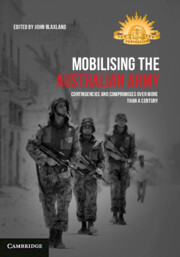Refine search
Actions for selected content:
342 results
Introduction
-
- Book:
- Huguenot Networks
- Published online:
- 28 November 2025
- Print publication:
- 18 December 2025, pp 1-16
-
- Chapter
- Export citation
Chapter 3 - The Cardinal and the Ambassador
-
- Book:
- Huguenot Networks
- Published online:
- 28 November 2025
- Print publication:
- 18 December 2025, pp 76-117
-
- Chapter
- Export citation
Allies and Access: Implications of an American Turn Away from Alliances
-
- Journal:
- International Organization / Volume 79 / Issue S1 / December 2025
- Published online by Cambridge University Press:
- 20 November 2025, pp. S103-S116
- Print publication:
- December 2025
-
- Article
-
- You have access
- Open access
- HTML
- Export citation
11 - Pearl Harbor
- from Part III - The Twentieth Century through World War II
-
- Book:
- Crises, War, and Diplomacy
- Published online:
- 07 November 2025
- Print publication:
- 20 November 2025, pp 210-240
-
- Chapter
- Export citation
The Firm, the Bank, and the Family: Military Intelligence and the Wallenbergs in Sweden’s Cold War
-
- Journal:
- Enterprise & Society , First View
- Published online by Cambridge University Press:
- 23 October 2025, pp. 1-30
-
- Article
-
- You have access
- Open access
- HTML
- Export citation
Chapter 11 - The Human Sciences and the “Theory of Women”
- from Part III - Interventions
-
-
- Book:
- Science and Humanism
- Published online:
- 09 October 2025
- Print publication:
- 23 October 2025, pp 239-262
-
- Chapter
-
- You have access
- Open access
- HTML
- Export citation
Sand in the gears: Sabotage in world politics
-
- Journal:
- European Journal of International Security , First View
- Published online by Cambridge University Press:
- 20 October 2025, pp. 1-20
-
- Article
-
- You have access
- Open access
- HTML
- Export citation
High intelligence is not associated with a greater propensity for mental health disorders – CORRIGENDUM
-
- Journal:
- European Psychiatry / Volume 68 / Issue 1 / 2025
- Published online by Cambridge University Press:
- 23 September 2025, e136
-
- Article
-
- You have access
- Open access
- HTML
- Export citation
How much like us?
-
- Journal:
- Religious Studies / Volume 61 / Issue 4 / December 2025
- Published online by Cambridge University Press:
- 02 September 2025, pp. 972-974
- Print publication:
- December 2025
-
- Article
-
- You have access
- Open access
- HTML
- Export citation

Operation Wrath of God
- The Secret History of European Intelligence and Mossad's Assassination Campaign
-
- Published online:
- 12 August 2025
- Print publication:
- 07 August 2025
Truth Telling, Trust, and Just Intelligence Theory
-
- Journal:
- Ethics & International Affairs / Volume 39 / Issue 1 / Spring 2025
- Published online by Cambridge University Press:
- 22 July 2025, pp. 89-101
-
- Article
-
- You have access
- Open access
- HTML
- Export citation
Introduction
-
-
- Book:
- Mobilising the Australian Army
- Published online:
- 23 May 2025
- Print publication:
- 30 May 2025, pp 1-10
-
- Chapter
- Export citation

Mobilising the Australian Army
- Contingencies and Compromises Over More than a Century
-
- Published online:
- 23 May 2025
- Print publication:
- 30 May 2025
3 - New Legal Families
- from Part I - Vanishing Trials, Transformed Legal Systems
-
- Book:
- Vanishing Legal Justice
- Published online:
- 20 March 2025
- Print publication:
- 03 April 2025, pp 60-86
-
- Chapter
- Export citation
Chapter 1 - Social and Emotional Intelligences
-
- Book:
- Essentials of Social and Emotional Intelligences
- Published online:
- 25 March 2025
- Print publication:
- 27 March 2025, pp 4-25
-
- Chapter
- Export citation
Chapter 5 - Neuropsychology
-
-
- Book:
- Essential Neuroscience for Psychiatrists
- Published online:
- 12 March 2025
- Print publication:
- 20 March 2025, pp 174-197
-
- Chapter
- Export citation
The Untold Story of Onodera Makoto's February 1945 Warning of the Coming Soviet Attack
-
- Journal:
- Asia-Pacific Journal / Volume 20 / Issue 8 / April 2022
- Published online by Cambridge University Press:
- 14 March 2025, e1
-
- Article
-
- You have access
- Open access
- Export citation
2 - Philosophy of AI
- from Part I - AI, Ethics and Philosophy
-
-
- Book:
- The Cambridge Handbook of the Law, Ethics and Policy of Artificial Intelligence
- Published online:
- 06 February 2025
- Print publication:
- 13 February 2025, pp 40-58
-
- Chapter
-
- You have access
- Open access
- HTML
- Export citation
Chapter Two - Brain Mechanisms of Aging
-
- Book:
- Cognitive and Social Neuroscience of Aging
- Published online:
- 14 February 2025
- Print publication:
- 13 February 2025, pp 23-54
-
- Chapter
- Export citation
The overlooked importance of intelligence analysis in IHL
-
- Journal:
- International Review of the Red Cross / Volume 107 / Issue 928 / April 2025
- Published online by Cambridge University Press:
- 20 January 2025, pp. 287-310
- Print publication:
- April 2025
-
- Article
-
- You have access
- Open access
- HTML
- Export citation
